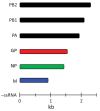Comprehensive Review of Emergence and Virology of Tickborne Bourbon Virus in the United States
- PMID: 36573641
- PMCID: PMC9796205
- DOI: 10.3201/eid2901.212295
Comprehensive Review of Emergence and Virology of Tickborne Bourbon Virus in the United States
Abstract
The emergence of SARS-CoV-2 and the worldwide COVID-19 pandemic triggered considerable attention to the emergence and evolution of novel human pathogens. Bourbon virus (BRBV) was first discovered in 2014 in Bourbon County, Kansas, USA. Since its initial discovery, several cases of BRBV infection in humans have been identified in Kansas, Oklahoma, and Missouri. BRBV is classified within the Thogotovirus genus; these negative-strand RNA viruses appear to be transmitted by ticks, and much of their biology remains unknown. In this review, we describe the emergence, virology, geographic range and ecology, and human disease caused by BRBV and discuss potential treatments for active BRBV infections. This virus and other emerging viral pathogens remain key public health concerns and require continued surveillance and study to mitigate human exposure and disease.
Keywords: Bourbon virus; RNA viruses; United States; emerging virus; thogotovirus; tickborne viruses; vector-borne infections; viruses; zoonoses.
Figures




References
-
- Lambert AJ, Velez JO, Brault AC, Calvert AE, Bell-Sakyi L, Bosco-Lauth AM, et al. Molecular, serological and in vitro culture-based characterization of Bourbon virus, a newly described human pathogen of the genus Thogotovirus. J Clin Virol. 2015;73:127–32. 10.1016/j.jcv.2015.10.021 - DOI - PMC - PubMed
Publication types
MeSH terms
Supplementary concepts
LinkOut - more resources
Full Text Sources
Medical
Miscellaneous

